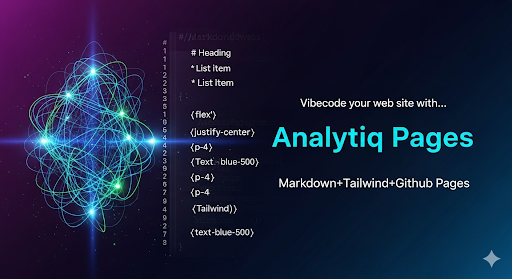Setting up a professional company website shouldn’t require a team of developers or expensive hosting solutions. Analytiq Pages is our streamlined approach to building beautiful, fast company websites using GitHub Pages, Jekyll, and Tailwind CSS - completely free and with enterprise-grade reliability.
📢 Join the Analytiq Pages discussion on LinkedIn
Why Analytiq Pages?
After building numerous company websites and helping startups establish their web presence, we’ve distilled the best practices into a reproducible system that delivers:
- Zero hosting costs with GitHub Pages
- Professional design with Tailwind CSS
- Easy content creation using Markdown
- Git sandbox edited with Claude Code, Cursor to create content and visualizations
- Fast deployment with git-based workflows
- Enterprise reliability backed by GitHub’s infrastructure
The Analytiq Pages Stack
GitHub Pages
Free, reliable hosting with enterprise-grade infrastructure
Jekyll
Write content in simple Markdown
Tailwind CSS
Embed HTML+Tailwind directly in Markdown for sophisticated layouts
Setting Up Your Company Website
The fastest way to get started is by using our reference implementation at analytiqhub.com as your starting point. This site demonstrates all the Analytiq Pages features in action and serves as a complete template for your company website. You’ll clone this proven foundation and customize it with your branding, content, and specific requirements.
Let’s walk through creating a professional company website using the Analytiq Pages approach.
Step 1: Repository Setup
Start by forking the Analytiq Pages reference implementation:
- Fork the repository: Go to https://github.com/analytiq-hub/analytiq-hub.github.io and click “Fork”
- Rename your fork: In your forked repository settings, rename it to
your-company.github.io - Clone for local development:
# Clone your forked repository
git clone https://github.com/your-company/your-company.github.io.git
cd your-company.github.io
Step 2: Customize for Your Company
Replace all Analytiq Hub references with your company information:
Key files to update:
_config.yml- Site configuration:title: Your Company Name email: contact@yourcompany.com description: Your company description baseurl: "" url: "http://your-company.github.io" github_username: yourcompanyindex.md- Homepage contentabout.md- Company information_posts/- Replace sample blog posts with your contentassets/images/- Replace logos and imagesCNAME- Update with your custom domain (if using one)
GitHub Pages setup:
- Go to your repository Settings → Pages
- Set source to “Deploy from a branch” → main
- Add custom domain if you have one
The forked template already includes Tailwind CSS configuration, so your site is ready to run locally with make dev or deploy immediately to GitHub Pages.
Step 3: Local Development Setup
Install local development prerequisites and start developing locally:
# Install dependencies
make install
# Start development server
make dev
For complete setup instructions including Ruby, Bundler, and troubleshooting, see the full Local Development Setup guide.
Point your web browser to the local development server at http://localhost:4000.
After editing files in the sandbox, manually or with Claude Code, Cursor or the preferred AI editor, they are automatically refreshed on the development server.
- Changes to the menu or the footing require a restart of the local development server.
- When later the github pages pipeline is setup, a push of local changes will trigger the web site update at https://your-company.github.io
Step 4: Essential Company Pages
Update the core pages with your company information:
index.md- Homepage with compelling hero section and company value propositionabout.md- Company story, team information, and missioncontact.md- Contact information and inquiry forms
Step 5: Header and Footer Customization
Start by configuring your site navigation in _config.yml:
# Header navigation menu
header_pages:
- title: "Services"
url: "#"
children:
- title: "Consulting"
url: "/consulting"
- title: "Development"
url: "/development"
- title: "Case Studies"
url: "/case-studies"
- title: "Blog"
url: "/blog"
- title: "About"
url: "/about"
- title: "Contact"
url: "/contact"
button_style: "solid"
# Footer sitemap
site_map:
- title: "Services"
links:
- title: "Consulting"
url: "/consulting"
- title: "Case Studies"
url: "/case-studies"
- title: "Company"
links:
- title: "About"
url: "/about"
- title: "Contact"
url: "/contact"
Then customize the visual elements:
_includes/custom-header.html- Company logo, announcements, search_includes/custom-footer.html- Contact info, social links, legal pages
Step 6: Blog Setup
Jekyll’s blog functionality is ready out of the box:
- Create posts in
_posts/using the format:YYYY-MM-DD-post-title.md - Posts automatically appear on your homepage and
/blogpage - Use front matter to set title, author, categories, and featured images
Step 7: Case Studies
Showcase your work with detailed case studies:
- Add case studies to the
_case_studies/collection - Use the case study template for consistent formatting
- Include client results, project images, and key outcomes
Step 8: (Advanced) Custom Components
The template includes Tailwind-powered components for:
- Call-to-action sections
- Team member profiles
- Service feature cards
- Client testimonials
Your AI editor can help create custom components by combining Jekyll’s liquid templating with Tailwind’s utility classes.
Step 9: (Advanced) Custom Layouts
Create specialized page layouts by extending the base templates:
_layouts/landing.html- For marketing campaigns and product launches_layouts/portfolio.html- Showcase projects with image galleries_layouts/team.html- Team member profiles with bios and photos
Copy existing layouts as starting points and modify with your specific content structure and Tailwind styling.
Deployment and Domain Setup
GitHub Pages Configuration
- Enable GitHub Pages in repository settings
- Set source to “Deploy from a branch” → main
- Custom domain: Add your company domain in settings
Domain Configuration
DNS Setup:
# For apex domain (company.com)
A record: 185.199.108.153
A record: 185.199.109.153
A record: 185.199.110.153
A record: 185.199.111.153
# For www subdomain
CNAME record: your-company.github.io
CNAME File:
echo "your-company.com" > CNAME
Analytiq Pages Best Practices
Content Strategy
- Homepage: Clear value proposition and call-to-action
- About: Company story and team credibility
- Services/Products: Detailed offering descriptions
- Blog: Regular insights to build authority
- Contact: Multiple ways to reach you
SEO Foundation
- Meta descriptions: Add to each page’s front matter
- Google Analytics: Add tracking code to
_includes/custom-head.html
Maintenance and Updates
The beauty of Analytiq Pages is its simplicity:
# Update content
git add .
git commit -m "Update company blog post"
git push origin main
# Site updates automatically within minutes
Why Companies Choose Analytiq Pages
- Startups: Get online fast without burning budget on hosting or developers
- Agencies: Deliver professional sites quickly for clients
- Enterprise: Maintain security and compliance with git-based workflows
- Content Teams: Edit in Markdown without technical dependencies
Conclusion
Analytiq Pages combines the best of modern web development - GitHub’s reliability, Markdown simplicity, and Tailwind’s design power - into a streamlined system perfect for company websites. Whether you’re launching a startup or refreshing an enterprise web presence, this approach delivers professional results without the complexity.
Ready to build your company website? Check out our Analytiq Pages starter template or contact us for custom implementation support.
Want to see Analytiq Pages in action? This very website was built using these exact techniques. View the source code to see how we implement our own recommendations.
 DocRouter.AI
DocRouter.AI
